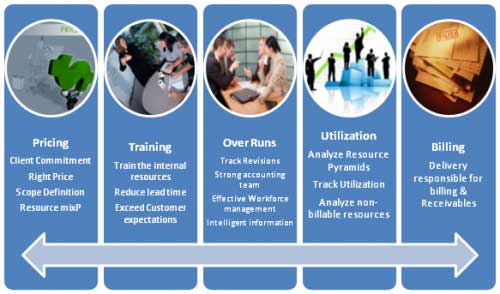How many times have you heard your project managers shy away from bidding and executing on fixed bid projects? Fixed bid projects have their own complications, but if executed correctly they can be very effective for organizational growth and can strengthen your bottom line.
Let us understand the five factors which can make or break a fixed bid project.
Pricing: The most important aspect of any fixed bid project is to get the pricing right. The successful fixed bid projects that I have worked on have had one thing in common. They were never priced without an assessment. In fact, most successful fixed bid projects are those where we have a T&M based assessment. This puts the onus on the client to help the consulting organization define a clear scope of work, builds commitment among the client team members to the project and helps the consulting organization decide the right price, resource mix and the deliverables.
No better training ground: No matter how comprehensive your training program is, there is never a substitute for real work experience. As the client does not control the staff we put on the project, if the right resources with the right approach and skill sets are put on the project, all fixed bid projects can provide invaluable on-the-job training or improve your utilization, and in some cases even reduce the turn-around time leading to exceeding expectations of the client. This works really well for companies with a dual shore model where the majority of the delivery happens offshore.

Tracking overruns: One of the most difficult aspects of any fixed bid project is not in getting it off the ground but in executing it without overruns. This however can be addressed by a combination of four factors:
- Effective internal systems to track the revisions in estimates.
- Strong back office and accounting team support to report on revenue overrun or under recognition.
- Strong workforce management team to track the utilization of resources.
- Close coordination between corporate teams, business unit heads and workforce teams to monitor the revenue trends.
Utilization: While fixed bid projects can be a great training ground, they can also be used by project managers and verticals to hide resources and show false utilization levels. This must be monitored to avoid such issues. Many organizations either struggle to realize this or fail to address this during growth spurts. Addressing this head on can lead to efficiencies and stronger profitability. A strong network of internal systems can provide the workforce managers the necessary information to proactively identify actual resource utilization, compare the resource matrix over time and put measures in place to track deviations.
Missed Billings: In a typical consulting setup where all the billing is handled by back office staff, some fixed bid projects can have missed or delayed billings leading to higher day sales outstanding (receivables). This is where organizations have to think outside the box. In order to be successful, the project manager and delivery manager has to be held responsible for billing. They have to indicate when a milestone is complete, send out the invoice to a customer and also be responsible for tracking the receivables. Holding delivery people responsible for receivables is not always a welcome measure but a very effective one.
What are your thoughts? Please share in the Comments field below.
Copyright © 2010 Sarat Varanasi


